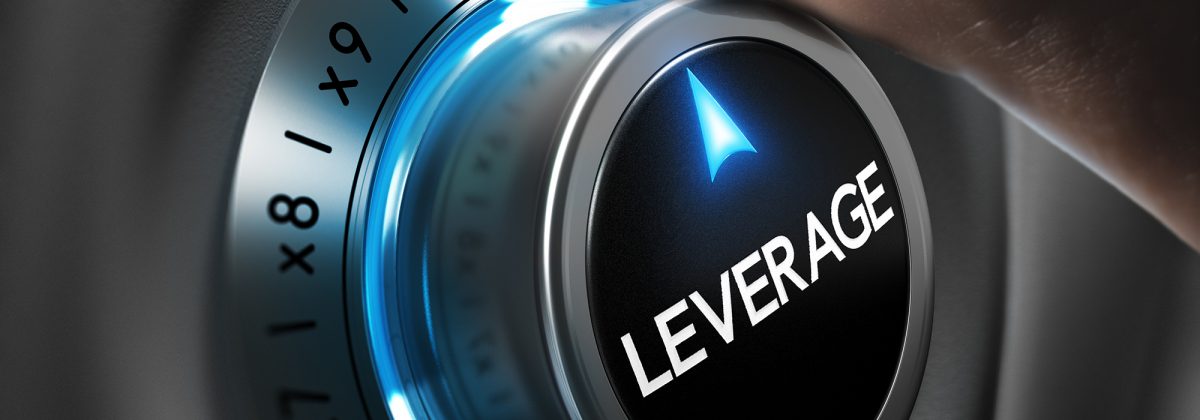Contracts for Difference (CFDs) are the preferred trading vehicle for many traders worldwide. The reason for this is the low initial capital required to start trading, degree of flexibility across all types of market conditions, perceived ease of trading and the leveraged opportunities they provide.
The power of leverage magnifies gains from small percentage movements of the underlying CFD instrument by increasing market exposure. But these movements can go against the trader as well, in which case the losses would be much larger too. This is why it is always recommended to learn as much as possible about leveraged trading and its consequences before committing real funds to it.
How does Leverage Work in Trading?
Leverage allows traders to maximise their potential returns. Traders borrow capital from brokers in order to enter larger trades than what they would have been able to with their own money alone. For example, in forex trading, brokers require traders to open a margin account with them. The amount of leverage provided could be as small as 50:1 or as high as 500:1, depending on the size of the brokerage and instruments being traded, as well as the risk profile of the trader.
In forex, a standard lot for trading is $100,000 of the quote currency. If the trader chooses a 50:1 leverage ratio, that means the account must have 1/50 = 2% of the total value of the trade available in cash, at all times. So, to trade $100,000 of the underlying currency in a CFD contract, a trader will need to deposit only $2,000 to open and maintain a trading account, rather than the full value of $100,000.
Movements in forex prices are measured in pips. For every pip movement, there will be 10 units change in the standard lot. If a trader has $10,000 worth of cash in the account, and chooses to opt for 50:1 leverage, they can enter into positions worth $500,000 in CFD trading. This is equivalent to 5 standard lots in forex trading. Here, each pip movement will cost $50. If the underlying instrument moves upwards by 50 pips, and the trader has a long position, the gain would be $50 x 50 pips = $2,500.
On the other hand, if the market goes against the trader, the loss would be $2,500 too, which is 25% of the entire trading account of $10,000.
Leverage Can Go Against You
Now, imagine this loss in a scenario where the leverage was 500:1, the maximum leverage offered by CFD brokers. In CFDs, the gains and losses are based on the full contract value, once the trade is closed. So, if the price moves in an unfavourable direction, the entire trading account could be wiped out.
Also, in case of leveraged trading for share CFDs, traders are giving up the right to get dividend payments. So, in case of a loss, instead of receiving a dividend, the loss amount will further get subtracted from their account.
In case of losses, traders will need to deposit additional funds to maintain the margin account to keep trades open. So, they can either deposit the required amount or close the positions to reduce exposure.
Deciding the Right Amount of Leverage
1. Finding a Regulated CFD Broker
Choosing the right CFD broker is part of the whole solution. Price is one of the factors that affects your returns. Choose a broker that offers tighter spreads and is market-neutral. They should also provide robust platforms for instant trade executions. A regulated broker will refrain from offering irresponsible leverage amounts like 1000:1. Top regulatory bodies like the FCA and ESMA restrict the amount of leverage offered to traders on CFD trading, to protect investor interests.
2. Trading Strategy
Traders have to first determine what kind of strategy they want to adopt for trading CFDs. For scalpers, using small price changes of the underlying asset to make gains, a higher leverage will be required to generate significant returns. For a trend following strategy, traders tend to track larger movements, which take time. In that case, lower leverage is preferred.
3. Risk-Reward Profile
For beginners, a conservative risk profile is more appropriate. For them, the leverage amounts have to be in the lower ranges between 5:1 and 50:1. Experienced traders are more comfortable with higher leverage ratios due to higher risk tolerance.
Along with the entry price, the amount that is put into trades can give an idea of how much money a trader can lose. For forex CFDs, brokers can offer mini lots and micro lots for trading, where the position size is smaller than the standard lot. In case you are uncomfortable with the amount of leverage being offered, simply opt to cut back on the position size.
Set a limit on the amount you are willing to lose in a trade from around 1% to 2% of your total trading capital. For this, you can do backward calculations to figure out what amount you need to put into a trade to minimise losses and decide on the leverage accordingly.
4. Behaviour of Underlying Instrument
The forex markets tend to have lower historical volatility than the markets for commodities, equities and indices. But the forex markets are extremely liquid for traders. Hence, forex CFDs tend to come with options for higher leverage. For shares and indices, with comparatively lower liquidity but higher price volatility, lower leverage would be preferred to protect positions against rapid price changes.
5. Risk Management
Setting stop-losses for your positions at the right levels will restrict losses when trades move in an unfavourable direction. These orders are also important for removing human bias and emotions from trading. In case the stop-losses aren’t triggered, due to certain market conditions, you can use trailing stops to guarantee the closure of positions at the decided price levels.
CFDs are useful products for gaining exposure to a wide range of markets, all from a single platform. But, leveraged CFDs also require good money management skills and support from a reliable broker. Fundamental analysis regarding the nature of the underlying market is also necessary to make informed trading decisions.
Reference Links





